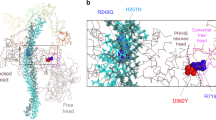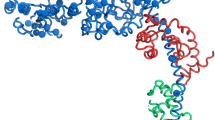Abstract
Familial hypertrophic cardiomyopathy (FHC) is a disease of the sarcomere. In the β-myosin heavy chain gene, which codes for the mechanical enzyme myosin, greater than 40 point mutations have been found that are causal for this disease. We have studied the effect of two mutations, the R403Q and L908V, on myosin molecular mechanics. In the in vitro motility assay, the mutant myosins produced a 30% greater velocity of actin filament movement (νactin). At the single molecule level, νactin ∼d/t on, where d is the myosin unitary step displacement and t on is the step duration. Laser trap studies were performed at 10 μM MgATP to estimate d and t on for the normal and mutant myosin molecules. The increase in νactin can be explained by a significant decrease in the average t on's in both the R403Q and L908V mutants (∼30 ms) compared to controls (∼40 ms), while d was not different for all myosins tested (∼7 nm). Thus the mutations affect the kinetics of the cross-bridge cycle without any effect on myosin's inherent motion and force generating capacity. Based on these studies, the primary signal for the hypertrophic response appears to be an apparent gain in function of the individual mutant myosin molecules.
Similar content being viewed by others
References
Becker KD, Gottshall KR, Hickey R, Perriard J-C and Chien KR (1997) Point mutations in human β cardiac myosin heavy chain have differential effects on sarcomeric structure and assembly: an ATP binding site change disrupts both think and thin filaments, whereas hypertrophic cardiomyopathy mutations display normal assembly. J Cell Biol 137: 131–140.
Bing W, Redwood CS, Purcell IF, Esposito G, Watkins H and Marston SB (1997) Effects of two hypertrophic cardiomyopathy mutations in α-tropomyosin, Asp175Asn and Glu180Gly, on Ca2+ regulation of thin filament motility. Biochem Biophys Res Comm 236: 760–764.
Blanchard EM, Seidman CE, Seidman JG, LeWinter M and Maughan D (1999) Altered crossbridge kinetics in the αMHC403/+ mouse model of familial hypertrophic cardiomyopathy. Circ Res 84: 475–483.
Bonne G, Carrier L, Richard P, Hainque B and Schwartz K (1998) Familial hypertrophic cardiomyopathy. Circ Res 83: 580–593.
Cuda G, Fananapazir L, Epstein ND and Sellers JR (1997) The in vitro motility activity of β-cardiac myosin depends on the nature of the β-myosin heavy chain gene mutation in hypertrophic cardiomyopathy. J Muscle Res Cell Motil 18: 275–283.
Cuda G, Fananapazir L, Zhu W-S, Sellers JR and Epstein ND (1993) Skeletal muscle expression and abnormal function of β-myosin in hypertrophic cardiomyopathy. J Clin Invest 91: 2861–2865.
Drexler H (1992) Skeletal muscle failure in heart failure. Circulation 85: 1621–1623.
Dupuis DE, Guilford WH, Wu J and Warshaw DM (1997) Actin filament mechanics in the laser trap. J Mus Res Cell Motil 18: 17–30.
Durand J-B, Anchee AB and Roberts R (1995) Molecular and clinical aspects of inherited cardiomyopathies. Annals of Medicine 27: 311–317.
Eldin P, LeCunff M, Mornet D and Leger J (1995) The cardiac myosin heavy chain Arg-403-Gln mutation that causes hypertrophic cardiomyopathy does not affect the actin-or ATP-binding capacities of two size-limited recombinant myosin heavy chain fragments. Biochem J 306: 345–351.
Fananapazir L and Epstein ND (1994) Genotype-phenotype correlations in hypertrophic cardiomyopathy. Circulation 89: 22–32.
Fenn WO (1924) The relationship between work performed and the energy liberated in muscular contraction. J Physiol 58: 373–395.
Fujita H, Suguira S, Momomura S-I, Omata M, Sugi H and Sutoh K (1997) Characterization of mutant myosins of Dictyostelium discoideum equivalent to human familial hypertrophic cardiomyopathy mutants. Molecular force level of mutant myosins may have a prognostic implication. J Clin Invest 99: 1010–1015.
Fujita H, Suguira S, Momomura S-I, Sugi H and Sutoh K (1998) Functional characterization of Dictyostelium discoideum mutant myosins equivalent to human familial hypertrophic cardiomyopathy. Adv Exp Med Biol 453: 131–137.
Gao WD, Perez NG, Seidman CE, Seidman JG and Marban E (1999) Altered cardiac excitation-contraction coupling in mutant mice with familial hypertrophic cardiomyopathy. J Clin Invest 103: 661–666.
Geisterfer-Lowrance A, Christe M, Conner DA et al. (1996) A mouse model of familial hypertrophic cardiomyopathy. Science 272: 731–734.
Georgakopoulos D, Christe ME, Giewat M, Seidman CE, Seidman JG and Kass DA (1999) The pathogenesis of familial hypertrophic cardiomyopathy: early and evolving effects from an α-cardiac myosin heavy chain missense mutation. Nature Medicine 5: 327–330.
Guilford WH, Dupuis DE, Kennedy G, Wu J, Patlak JB and Warshaw DM (1997) Smooth muscle and skeletal muscle myosins produce similar unitary forces and displacements in the laser trap. Biophys J 72: 1006–1021.
Haeberle JR (1994) Calponin decreases the rate of cross-bridge cycling and increases maximum force production by smooth muscle myosin in an in vitro motility assay. J Biol Chem 269: 12424–12431.
Harris DE, Work SS, Wright RK, Alpert NR and Warshaw DM (1994) Smooth, cardiac and skeletal muscle myosin force and motion generation assessed by cross-bridge mechanical interactions in vitro. J Muscle Res Cell Motil 15: 11–19.
Lankford EB, Epstein ND, Fananapazir L and Sweeney HL (1995) Abnormal contractile properties of muscle fibers expressing β-myosin heavy chain gene mutations in patients with hypertrophic cardiomyopathy. J Clin Invest 95: 1409–1414.
Lauzon A-M, Tyska MJ, Rovner AS, Freyson Y, Warshaw DM and Trybus KM (1998) A 7 amino acid insert in the heavy chain nucleotide binding loop alters the kinetics of smooth muscle myosin in the laser trap. J Muscle Res Cell Mot 19: 825–837.
Marian AJ, Yu Q-T, Mann DL, Graham FL and Roberts R (1995) Expression of a mutation causing hypertrophic cardiomyopathy disrupts sarcomere assembly in adult feline cardiac myocytes. Circ Res 77: 98–106.
Molkentin JD, Lu J-R, Antos CL et al. (1998) A calcineurin-dependent transcriptional pathway for cardiac hypertrophy. Cell 93: 215–228.
Moss RL and Periera JS (2000) Enhanced myosin function due to a point mutation causing a familial hypertrophic cardiomyopathy. Circ Res 86: 720–722.
Nguyen T-TT, Hayes E, Mulieri LA et al. (1996) Maximal actomyosin ATPase activity and in vitro myosin motility are unaltered in human mitral regurgitation heart failure. Circ Res 79: 222–226.
Palmiter KA, Tyska MJ, Dupuis DE, Alpert NR and Warshaw DM (1999) Kinetic differences determined at the single molecule level account for the functional diversity of the cardiac V1 and V3 myosin isoforms. J Physiol 519: 669–678.
Pardee JD and Spudich JA (1982) Purification of muscle actin. Methods Cell Biol 24: 271–289.
Patlak JB (1993) Measuring kinetics of complex single ion channel data using mean-variance histograms. Biophys J 65: 29–42.
Poetter K, Jiang H, Hassanzadeh S et al. (1996) Mutations in either the essential or regulatory light chains of myosin are associated with a rare myopathy in human heart and skeletal muscle. Nature Genetics 13: 63–69.
Rayment I, Holden HM, Sellers JR, Fananapazir L and Epstein ND (1995) Structural interpretation of the mutations in the β-cardiac myosin that have been implicated in familial hypertrophic cardiomyopathy. Proc Natl Acad Sci USA 92: 3864–3868.
Roopnarine O and Leinwand L (1998) Functional analysis of myosin mutations that cause familial hypertrophic cardiomyopathy. Biophys J 75: 3023–3030.
Sata M and Ikebe M(1996) Functional analysis of the mutations in the human cardiac β-myosin that are responsible for familial hypertrophic cardiomyopathy. J Clin Invest 98: 2866–2873.
Seidman CE and Seidman JG (1998) Molecular genetic studies of familial hypertrophic cardiomyopathy. Basic Res Cardiol 93: 13–16.
Spindler M, Saupe KW, Christe ME, Sweeney HL, Seidman CE and Seidman JG (1998) Diastolic dysfunction and altered energetics in the αMHC403/+ mouse model of familial hypertrophic cardiomyopathy. J Clin Invest 101: 1775–1783.
Straceski AJ, Geisterfer-Lowrance A, Seidman CE, Seidman JG and Leinwand LA (1994) Functional analysis of myosin missense mutations in familial hypertrophic cardiomyopathy. Proc Natl Acad Sci USA 91: 589–593.
Suguira S, Kobayakawa N, Momomura S, Chaen S, Omata M and Sugi H (1996) Different cardiac myosin isoforms exhibit equal force-generating ability in vitro. Biochem Biophys Acta 1273: 73–76.
Sweeney HL, Feng HS, Yang Z and Watkins H (1998) Functional analysis of troponin T mutations that cause hypertrophic cardiomyopathy: insights into disease pathogenesis and troponin function. Proc Natl Acad Sci USA 95: 14406–14410.
Sweeney HL, Straceski AJ, Leinwand L, Tikunov BA and Faust L (1994) Heterologous expression of a cardiomyopathic myosin that is defective in its actin interaction. J Biol Chem 269: 1603–1605.
Thompson CH, Kemp GJ, Taylor DJ et al. (1997) Abnormal skeletal muscle bioenergetics in familial hypertrophic cardiomyopathy. Heart 78: 177–181.
Tyska MJ, Dupuis DE, Guilford WH et al. (1999) Two heads of myosin are better than one for generating force and motion. Proc Natl Acad Sci USA 96: 4402–4407.
Tyska MJ, Hayes E, Giewat M, Seidman JG, Seidman CE and Warshaw DM (2000) Single molecule mechanics of R403Q mutant cardiac myosin isolated from the mouse model of familial hypertrophic cardiomyopathy. Circ Res 86: 737–744.
Vale RD and Milligan RA (2000) The way things move: looking under the hood of molecular motor proteins. Science 288: 88–95.
VanBuren P, Harris DE, Alpert NR and Warshaw DM (1995) Cardiac V1 and V3 myosins differ in their hydrolytic and mechanical activities in vitro. Circ Res 77: 439–444.
Vybiral T, Deitiker PR, Roberts R and Epstein HF (1992) Accumulation and assembly of myosin in hypertrophic cardiomyopathy with the 403 Arg to Gln β-myosin heavy chain mutation. Circ Res 71: 1404–1409.
Warshaw DM, Desrosiers JM, Work SS and Trybus KM (1990) Smooth muscle myosin cross-bridge interactions modulate actin filament sliding velocity in vitro. J Cell Biol 111: 453–463.
Yamashita H, Tyska MJ, Warshaw DM, Lowey S and Trybus KM (2000) Functional consequences of mutations in the smooth muscle myosin heavy chain at sites implicated in familial hypertrophic cardiomyopathy. J Biol Chem 275: 28045–28052.
Yu Q-T, Ifegwu J, Marlan AJ et al. (1993) Hypertrophic cardiomypathy mutation is expressed in messenger RNA of skeletal as well cardiac muscle. Circ Res 87: 406–412.
Author information
Authors and Affiliations
Rights and permissions
About this article
Cite this article
Palmiter, K.A., Tyska, M.J., Haeberle, J.R. et al. R403Q and L908V mutant β-cardiac myosin from patients with familial hypertrophic cardiomyopathy exhibit enhanced mechanical performance at the single molecule level. J Muscle Res Cell Motil 21, 609–620 (2000). https://doi.org/10.1023/A:1005678905119
Issue Date:
DOI: https://doi.org/10.1023/A:1005678905119




